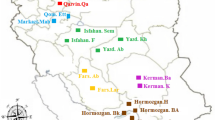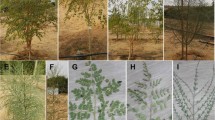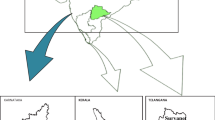Abstract
Eplingiella fruticosa, popularly known as “alecrim-de-vaqueiro”, is an aromatic and medicinal plant of the Lamiaceae family, endemic to the coastal region of northeastern Brazil. The objective of this study was to evaluate, in 12 genotypes of E. fruticosa, the variation of 16 morpho-agronomic markers related to the plant and leaves, as well as to identify the phytochemical compounds present in the essential oil (EO) of this species. The essential oil was obtained from dry leaves by hydrodistillation and analyzed by gas chromatograph coupled to mass spectrometer and a flame ionization detector (GC–MS/FID). The data were evaluated using multivariate analysis via the unweighted pair group method with arithmetic mean (UPGMA) for hierarchical clustering with canonical variables. Based on the morpho-agronomic data obtained, the formation of at least three groups was observed. The characteristics that most contributed to the formation of the groups were left petiole length, fresh leaf weight and leaf length. The genotypes EF002, EF003, EF005 and EF012 stood out by presenting greater genetic distances, indicating good potential for use in breeding programs aimed at foliar biomass production. A total 15 constituents were identified in the EOs, of which (E)-caryophyllene, bicyclogermacrene and α-pinene were the main components of all genotypes. Diversity classification based on chemical composition of EOs put them into groups. The highest detected components in the respective genotypes were: Group 1, represented by seven genotypes, containing (E)-caryophyllene (8.61–13.15%) and bicyclogermacrene (7.15–13.25%) as major compounds; Group 2, consisting of two genotypes, with (E)-caryophyllene (14.42–16.36%) and bicyclogermacrene (16.96–19.82%) as major compounds; Group 3, represented by two individuals, with highest production of (E)-caryophyllene (13.86–14.98%); and Group 4, with only one genotype, containing α-pinene (12.0%) as the major compound. The results of the present study can contribute to a better understanding and management of conservation and breeding of E. fruticosa germplasm. In addition, the results show the potential of the essential oils of this species and their major compounds for the development of new pharmaceutical products.







Similar content being viewed by others
Abbreviations
- DAP:
-
Days after planting
- LFW:
-
Leaf fresh weight
- LDW:
-
Leaf dry weight
- LL:
-
Leaf length
- LW:
-
Leaf width
- RPL:
-
Right petiole length
- LPL:
-
Left petiole length
- PW:
-
Petiole width
- EPL:
-
Essential oil of E. fruticosa
- EOC:
-
Essential oil content
- EOY:
-
Essential oil yield
- GC–MS:
-
Gas chromatography–mass spectrometry
- FID:
-
Flame ionization detection
- UPGMA:
-
Unweighted pair group method with arithmetic mean
References
Adams RP (2007) Identification of essential oil components by gaschromatography/quadupole mass spectroscopy, 4th edn. Allured Publishing Corporation Carol Stream
Andrade IS, Melo CF, Nunes GHS, Holanda ISA, Grangeiro LC, Corrêa RX (2019) Morphoagronomic genetic diversity of Brazilian melon accessions based on fruit traits. Sci Hortic 24:514–523. https://doi.org/10.1016/j.scienta.2018.09.006
Araghi AM, Nemati H, Azizi M, Moshtaghi N, Shoor M, Hadian J (2019) Assessment of phytochemical and agro-morphological variability among different wild accessions of Mentha longifolia L. cultivated in field condition. Ind Crops Prod 140:111698. https://doi.org/10.1016/j.indcrop.2019.111698
Bahadirli NP, Ayanoglu F (2024) Artificial hybridization in the Salvia genus (S. aramiensis Rech. Fil., S. fruticosa Mill. and S. officinalis L.) for herbal tea production, determination of some morphologic and quality properties of chosen hybrids. Sci Hortic 327:1–8. https://doi.org/10.1016/j.scienta.2024.112875
Bakha M, Mtili NE, Machon N, Aboukhalid K, Amchra FZ, Khiraoui A, Gibernau M, Tomi F, Faiz CA (2020) Intraspecific chemical variability of the essential oils of Moroccan endemic Origanum elongatum L. (Lamiaceae) from its whole natural habitats. Arab J Chem 13:3070–3081. https://doi.org/10.1016/j.arabjc.2018.08.015
Barreto IC, Costa SPM, Santos AJ, Farias AP, Sarmento VHV, Teodoro AV, Nunes RS, Sena Filho JG (2022) Incorporation of essential oil from Vitex gardneriana (Lamiaceae) in microemulsions systems based on mineral and cottonseed oils increased its bioactivity against a coconut pest mite. Ind Crops Prod 183:114963. https://doi.org/10.1016/j.indcrop.2022.114963
Beserra-Filho JIA, Macêdo AM, Leão AHFF, Bispo JMM, Santos JR, Oliveira-Melo AJ, Menezes PP, Duarte MC, Araújo AAS, Silva RH, Quintans-Júnior LJ, Ribeiro AM (2019) Eplingiella fruticosa leaf essential oil complexed with β-cyclodextrin produces a superior neuroprotective and behavioral profile in a mice model of Parkinson’s disease. Food Chem Toxicol 124:17–29. https://doi.org/10.1016/j.fct.2018.11.056
Carović-Stanko K, Petek M, Grdiša M, Pintar J, Bedeković D, Herak Ćustić M, Satovic Z (2016) Medicinal plants of the family Lamiaceae as functional foods-a review. Czech J Food Sci 34:377–390. https://doi.org/10.17221/504/2015-CJFS
Chen WN, Chin KW, Tang KS, Agatonovic-Kustrinc S, Yeong KY (2023) Neuroprotective, neurite enhancing, and cholinesterase inhibitory effects of Lamiaceae family essential oils in Alzheimer’s disease model. J Herb Med 41:1–9. https://doi.org/10.1016/j.hermed.2023.100696
Chiomento JLT, Lima EP Jr, D’Agostini M, Nardi FS, Trentin TS, Dornelles AG, Huzar-Novakowiski J, Calvete EO (2021) Horticultural potential of nine strawberry cultivars by greenhouse production in Brazil: a view through multivariate analysis. Sci Hortic 279:109738. https://doi.org/10.1016/j.scienta.2020.109738
Chograni H, Riahi L, Messaoud C (2021) Variability of qualitative and quantitative secondary metabolites traits among wild genetic resources of Lavandula stoechas L. Biochem Syst Ecol 98:104327. https://doi.org/10.1016/j.bse.2021.104327
Costa AS, Arrigoni-Blank MF, Carvalho Filho JLS, Santana ADD, Santos DA, Alves PB, Blank AF (2015) Chemical diversity in Basil (Ocimum sp.) germplasm. Sci World J 2015:352638. https://doi.org/10.1155/2015/352638
El-Aziz MA, Farid S, Elkomey S (2016) Evaluation of molecular and phenotypic diversity in relation to heterosis in some tomato lines under different climatic conditions. J Agric Chem Biotechnol 7:141–151. https://doi.org/10.21608/jacb.2016.40796
Embrapa (2018) Sistema Brasileiro de Classificação de Solos. Embrapa Solos, Brasília
Feijó EVRS, Barbosa BL, Berg CVD, Oliveira LM (2022) Genetic diversity of Lippia origanoides Kunth. in natural populations using ISSR marker. Ciênc Agrotec 46:e000822. https://doi.org/10.1590/1413-7054202246000822
Franco CRP, Alves PB, Andrade DM, Jesus HCR, Silva EJS, Santos EAB, Antoniolli AR, Quintans-Júnior LJ (2011a) Essential oil composition and variability in Hyptis fruticosa. Braz J Pharmacogn 21:24–32. https://doi.org/10.1590/S0102-695X2011005000034
Franco CRP, Antoniolli AR, Guimarães AG, Andrade DM, Jesus HCR, Alves PB, Bannet LE, Patrus AH, Azevedo EG, Queiroz DB, Quintans-Júnior LJ, Botelho MA (2011b) Bioassay-guided evaluation of antinociceptive properties and chemical variability of the essential oil of Hyptis fruticosa. Phytother Res 25:1693–1699. https://doi.org/10.1002/ptr.3455
Franco CDJP, Ferreira OO, Moraes AAB, Varela ELP, Nascimento LDD, Percário S, Oliveira MS, Andrade EHDA (2021) Chemical composition and antioxidant activity of essential oils from Eugenia patrisii Vahl, E. punicifolia (Kunth) DC., and Myrcia tomentosa (Aubl.) DC., leaf of family Myrtaceae. Molecules 26:1–12. https://doi.org/10.3390/molecules26113292
Gezici S, Turkmen M, Karahan F (2024) Exploring the anti-cancer properties of essential oils from some Lamiaceae species against human cancer cells with multivariate analysis. S Afr J Bot 166:1–10. https://doi.org/10.1016/j.sajb.2023.10.057
Henríquez JC, Duarte LV, Sierra LJ, Fernández-Alonso JL, Martínez JR, Stashenko EE (2023) Chemical composition and in vitro antioxidant activity of Salvia aratocensis (Lamiaceae) essential oils and extracts. Molecules 28:4062. https://doi.org/10.3390/molecules28104062
Herraiz-Peñalver D, Cases MÁ, Varela F, Navarrete P, Sánchez-Vioque R, Usano-Alemany J (2013) Chemical characterization of Lavandula latifolia Medik. essential oil from Spanish wild populations. Biochem Syst Ecol 46:59–68. https://doi.org/10.1016/j.bse.2012.09.018
Hong Y, Pandey MK, Lu Q, Liu H, Gangurde SS, Li S, Liu H, Li H, Liang X, Varshney RK, Chen X (2021) Genetic diversity and distinctness based on morphological and SSR markers in peanut. Agron J 113:4648–4660. https://doi.org/10.1002/agj2.20671
Ibrahim L, Bassal A, El Ezzi A, El Ajouz N, Ismail A, Karaky L, Kfoury L, Sassine Y, Zeineddine A, Ibrahim SK (2012) Characterization and identification of Origanum spp. from Lebanon using morphological descriptors. World Res J Agric Biotechnol 1:4–9
Karagoz H, Cakmakci R, Hosseinpour A, Ozkan G, Haliloglu K (2020) Analysis of genetic variation and population structure among of oregano (Origanum acutidens L.) accessions revealed by agro-morphological traits, oil constituents and retrotransposon-based inter-primer binding sites (iPBS) markers. Genet Resour Crop Evol 67:1367–1384. https://doi.org/10.1007/s10722-020-00887-7
Khadivi A, Heidari P, Rezaei M, Safari-Khuzani A, Sahebi M (2019) Morphological variabilities of Crataegus monogyna and C. pentagyna in northeastern areas of Iran. Ind Crops Prod 139:111531. https://doi.org/10.1016/j.indcrop.2019.111531
Kharazian N (2012) Morphometric study of some Salvia L. (Lamiaceae) species in Iran. Sci J Biol Sci 1:126–137. https://doi.org/10.14196/SJBS.V1I6.371
Koohdar F, Sheidai M (2022) Genetic diversity and population structure in medicinal plant Melissa officinalis L. (Lamiaceae). Genet Resour Crop Evol 69:1753–1758. https://doi.org/10.1007/s10722-021-01338-7
Kumar A, Mishra P, Rodrigues V, Baskaran K, Verma RS, Padalia RC, Sundaresana V (2019) Delineation of Ocimum gratissimum L. complex combining morphological, molecular and essential oils analysis. Ind Crops Prod 139:1–8. https://doi.org/10.1016/j.indcrop.2019.111536
Leontaritou P, Lamari FN, Papasotiropoulos V, Iatrou G (2020) Morphological, genetic and essential oil variation of Greek sage (Salvia fruticosa Mill.) populations from Greece. Ind Crops Prod 150:1–15. https://doi.org/10.1016/j.indcrop.2020.112346
Luo W, Duo Z, Zheng Y, Liang X, Huang G, Zhang Q, Liu Z, Zhang K, Lin L, Zhang L (2019) Phytochemical composition and bioactivities of essential oils from six Lamiaceae species. Ind Crops Prod 133:357–364. https://doi.org/10.1016/j.indcrop.2019.03.025
Marques CTS, Gama EVS, Silva F, Teles S, Caiafa AN, Lucchese AM (2018) Improvement of biomass and essential oil production of Lippia alba (Mill) N.E. Brown with green manures in succession. Ind Crops Prod 112:113–118. https://doi.org/10.1016/j.indcrop.2017.10.065
Melo AJO, Heimarth L, Carvalho AMS, Quintans JSS, Serafini MRS, Araújo AAS, Alves PB, Ribeiro AM, Saravanan S, Quintans LJ Jr, Duarte MC (2020) Eplingiella fruticosa (Lamiaceae) essential oil complexed with β-cyclodextrin improves its anti-hyperalgesic effect in a chronic widespread non-inflammatory muscle pain animal model. Food Chem Toxicol 135:3–9. https://doi.org/10.1016/j.fct.2019.110940
Mendes GC, Gusmão MTA, Martins TGV, Rosado RDS, Sobrinho RSA, Nunes ACP, Ribeiro WS, Zanuncio JC (2019) Genetic divergence of native palms of Oenocarpus distichus considering biometric fruit variables. Sci Rep 9:4943. https://doi.org/10.1038/s41598-019-41507-4
Menezes IAC, Marques MS, Santos TC, Dias KS, Silva AB, Mello ICM, Lisboa ACCD, Alves PB, Cavalcanti SCH, Marçal RM, Antoniolli AR (2007) Antinociceptive effect and acute toxicity of the essential oil of Hyptis fruticosa in mice. Fitoterapia 78:192–195. https://doi.org/10.1016/j.fitote.2006.11.020
Moetamedipoor SA, Saharkhiz MJ, Khosravi AR, Jowkar A (2021) Essential oil chemical diversity of Iranian mints. Ind Crops Prod 172:114039. https://doi.org/10.1016/j.indcrop.2021.114039
Mojena R (1977) Hierarchical grouping methods and stopping rules: an evaluation. Comput J 20:359–363. https://doi.org/10.1093/comjnl/20.4.359
Mokhtarikhah G, Ebadi MT, Ayyari M (2022) Agro-morphological and phytochemical studies of spearmint landraces (Mentha spicata L.) in Iran. Ind Crops Prod 176:114367. https://doi.org/10.1016/j.indcrop.2021.114367
Monteiro VA, Amabile RF, Spehar CR, Faleiro FG, Vieira EA, Peixoto JR, Ribeiro WQ, Montalvao AL (2020) Genetic diversity among 435 barley accessions based in morpho-agronomical characteristics under irrigation in the Brazilian savannah. Aust J Crop Sci 14:1385–1393. https://doi.org/10.21475/ajcs.20.14.09.p2281
Mounira GM, Ahlem Z, Mariem BA, Romdhane M, Okla MK, Al-Hashimi A, Alwase YA, Madnay MM, AbdElgayed G, Asard H, Beemster GTS, AbdElgawad H (2022) Essential oil composition and antioxidant and antifungal activities of two varieties of Ocimum basilicum L. (Lamiaceae) at two phenological stages. Agronomy 12:1–17. https://doi.org/10.3390/agronomy12040825
Naidoo Y, Dladla T, Dewir YH, Gangaram S, Naidoo CM, Rihan HZ (2021) The micromorphology and histochemistry of foliar mixed indumentum of Leucas lavandulaefolia (Lamiaceae). Plants 10:1767. https://doi.org/10.3390/plants10091767
Pandey SK, Baruah J, Paw M, Sarma N, Bergum T, Lal M (2022) Genetic parameters, association and genetic divergence study of the mutant (M4) population created through chemical and physical mutagenic agents for estimating selection criteria for essential oil yield in Pogostemon cablin Benth. Ind Crops Prod 184:115057. https://doi.org/10.1016/j.indcrop.2022.115057
Pinto JAO, Oliveira AKS, Santos EWP, Silva AO, Blank AF, Corrêa CB, Nogueira PCL, Arrigoni MF (2021) Essential oils of Eplingiella fruticosa populations: chemical, antioxidant, and cytotoxic analyses. Res Soc Dev 10:e341101623723. https://doi.org/10.33448/rsd-v10i16.23723
Pourhosseini SH, Hadian J, Sonboli A, Ebrahimi SN, Mirjalil MH (2018) Genetic and chemical diversity in Perovskia abrotanoides KAR. (Lamiaceae) populations based on ISSRS markers and essential oils profile. Chem Biodivers 15:e1700508. https://doi.org/10.1002/cbdv.201700508
R Development Core Team (2021) R: A language and environment for statistical computing. Vienna: R Foundation for statistical computing. http://R-project.org/. Accessed 30 May 2022
Sant’Anna ICC, Cruz CD, Gouvêa LRL, Scaloppi EJ Jr, Freitas RS, Gonçalves PS (2021) Genetic diversity analyses of rubber tree genotypes based on UPOV descriptors. Ind Crops Prod 165:113416. https://doi.org/10.1016/j.indcrop.2021.113416
Santos MRV, Carvalho AA, Medeiros IA, Alves PB, Marchioro M, Antoniollia AR (2007) Cardiovascular effects of Hyptis fruticosa essential oil in rats. Fitoterapia 78:186–191. https://doi.org/10.1016/j.fitote.2006
Santos E, Leitão MM, Ito CNA, Silva-Filho SE, Arena AC, Silva-Comar FMS, Cuman RKN, Oliveira RJ, Formagio ASN, Kassuya CAL (2021) Analgesic and anti-inflammatory articular effects of essential oil and camphor isolated from Ocimum kilimandscharicum Gürke leaves. J Ethnopharmacol 269:113697. https://doi.org/10.1016/j.jep.2020.113697
SEI (2014) Superintendência de Estudos Econômicos e Sociais da Bahia. Cartografia Temática - Divisão Político Administrativa – Mapas Estaduais. Retrieved from https://sei.ba.gov.br/index.php?option=com_content&view=article&id=104:mapasestaduais&catid=1550&Itemid=502&lang=pt. Accessed 11 Dec 2023
Shanaida M, Hudz N, Białon M, Kryvtsowa M, Svydenko L, Filipska A, Wieczorek PP (2021) Chromatographic profiles and antimicrobial activity of the essential oils obtained from some species and cultivars of the Mentheae tribe (Lamiaceae). Saudi J Biol Sci 28:6145–6152. https://doi.org/10.1016/j.sjbs.2021.06.068
Silva WJ, Dória GAA, Maia RT, Nunes RS, Carvalho G, Blank AF, Alves PB, Marcal R, Cavalcanti S (2008) Effects of essential oils on Aedes aegypti larvae: alternatives to environmentally safe insecticides. Bioresour Technol 99:3251–3255. https://doi.org/10.1016/j.biortech.2007.05.064
Silva DC, Blank AF, Nizio DAC, Sampaio TS, Nogueira PCL, Arrigoni-Blank MF (2018) Chemical diversity of essential oils from native populations of Eplingiella fruticosa. Crop Breed Appl Biotechnol 18:205–214. https://doi.org/10.1590/1984-70332018v18n2n29
Silva DC, Arrigoni-Blank MF, Bacci L, Blank AF, Faro RRN, Pinto JAO, Pereira KLG (2019) Toxicity and behavioral alterations of essential oils of Eplingiella fruticosa genotypes and their major compounds to Acromyrmex balzani. Crop Prot 116:181–187. https://doi.org/10.1016/j.cropro.2018.11.002
Silva LRR, Ferreira OO, Cruz JN, Franco CJP, Anjos TO, Cascaes MM, Costa WA, Andrade EHA, Oliveira MS (2021) Lamiaceae essential oils, phytochemical profile, antioxidant, and biological activities. Hindawi 2021:1–18. https://doi.org/10.1155/2021/6748052
Singh D (1981) The relative importance of characters affecting genetic divergence. Indian J Genet Plant Breed 41:237–245
Skendi A, Katsantonis DN, Chatzopoulou P, Irakli M, Papageorgiou M (2020) Antifungal activity of aromatic plants of the Lamiaceae family in bread. Foods 9:1–20. https://doi.org/10.3390/foods9111642
Sokal RR, Rohlf FJ (1962) The comparison of dendrograms by objective methods. Taxon 11:33–40. https://doi.org/10.2307/1217208
Srivastava S, Maurya RKL, Mishra A, Yadav AK, Pandey G, Rout PK, Chanotiya CS (2021) Chemical diversity of essential oil among basil genotypes (Ocimum viride Willd.). Ind Crops Prod 173:114153. https://doi.org/10.1016/j.indcrop.2021.114153
Sun X, Wang F, Cui R, Liu X, Li X, Dong J, Sun L, Qin S, Wang R, Zheng P, Wang H (2020) Studies on reproductive strategies of Vitex negundo L. var. randomly collected (Franch.) Rehder (Lamiaceae) based on morphological characteristics and SSR markers. Ecol Evolution 10:5270–5280. https://doi.org/10.1002/ece3.6271
Sun J, Sun P, Sun J, Sun P, Kang C, Zhang L, Guo L, Kou Y (2022) Chemical composition and biological activities of essential oils from six Lamiaceae folk medicinal plants. Front Plant Sci 13:1–18. https://doi.org/10.3389/fpls.2022.919294
Talebi SM, Tabaripour R, Matsyura A (2022) Genetic diversity and population structure of diverse Iranian Nepeta L. taxa. Gen Res Crop Evol 69:285–296. https://doi.org/10.1007/s10722-021-01228-y
Teles S, Pereira JA, Oliveira LM, Malheiro R, Machado SS, Lucchesec AM, Silva F (2014) Organic and mineral fertilization influence on biomass and essential oil production: composition and antioxidant activity of Lippia origanoides H.B.K. Ind Crops Prod 59:169–176. https://doi.org/10.1016/j.indcrop.2014.05.010
Tibaldi H, Hazrati S, Hosseini SJ, Ertani A, Bulgari R, Nicola S (2022) Cultivation techniques and drying process can affect the inflorescence essential oil composition of three selections of Salvia officinalis. Ind Crops Prod 183:114923. https://doi.org/10.1016/j.indcrop.2022.114923
Türkmen M, Karo M, Maral H, Soylu S (2021) Determination of chemical component of essential oil of Origanum dubium plants grown at different altitudes and antifungal activity against Sclerotinia sclerotiorum. J Food Process Preserv 46:1–10. https://doi.org/10.1111/jfpp.15787
Zhakipbekov K, Turgumbayeva A, Akhelova S, Bekmuratova K, Blinova O, Utegenova G, Shertaeva K, Sadykov N, Tastambek K, Saginbazarova A, Urazgaliyev K, Tulegenova G, Zhalimova Z, Karasova Z (2024) Antimicrobial and other pharmacological properties of Ocimum basilicum, Lamiaceae. Molecules 29:1–19. https://doi.org/10.3390/molecules29020388
Acknowledgements
The authors thank the Coordenação de Aperfeiçoamento de Pessoal de Nível Superior (CAPES) for financial support (001) and for the postdoctoral research grant given to the fifth (PNPD/UEFS 15950830814) author. Also thank the Conselho Nacional de Desenvolvimento Científico e Tecnológico (CNPq) for financial support.
Funding
This research was supported by Grant from Coordenação de Aperfeiçoamento de Pessoal de Nível Superior (PNPD/UEFS 15950830814).
Author information
Authors and Affiliations
Contributions
Anderson Silva: conceptualization, methodology, investigation, data curation, writing—original draft preparation; Lenaldo Oliveira: conceptualization, investigation, methodology, resources, data curation, writing—original draft, writing—review & editing, supervision, funding acquisition; Angélica Lucchese: conceptualization, resources, methodology, data curation, formal analysis, data curation, writing—original draft, supervision; José Pastore—visualization, methodology, data curation, writing—original draft preparation; Taliane Soares: conceptualization, visualization, formal analysis, writing—review & editing; Everton Souza: visualization, writing—review & editing.
Corresponding author
Ethics declarations
Confict of interest
The authors declare that they have no known competing financial interests or personal relationships that could have appeared to influence the work reported in this paper.6
Additional information
Publisher's Note
Springer Nature remains neutral with regard to jurisdictional claims in published maps and institutional affiliations.
Supplementary Information
Below is the link to the electronic supplementary material.
Rights and permissions
Springer Nature or its licensor (e.g. a society or other partner) holds exclusive rights to this article under a publishing agreement with the author(s) or other rightsholder(s); author self-archiving of the accepted manuscript version of this article is solely governed by the terms of such publishing agreement and applicable law.
About this article
Cite this article
Carvalho Silva, A.d., de Oliveira, L.M., Lucchese, A.M. et al. Assessment of the genetic diversity of Eplingiella fruticosa (Salzm. ex Benth.) Harley & J.F.B.Pastore (Lamiaceae) based on morpho-agronomic markers and chemical composition of essential oils. Genet Resour Crop Evol (2024). https://doi.org/10.1007/s10722-024-01942-3
Received:
Accepted:
Published:
DOI: https://doi.org/10.1007/s10722-024-01942-3




